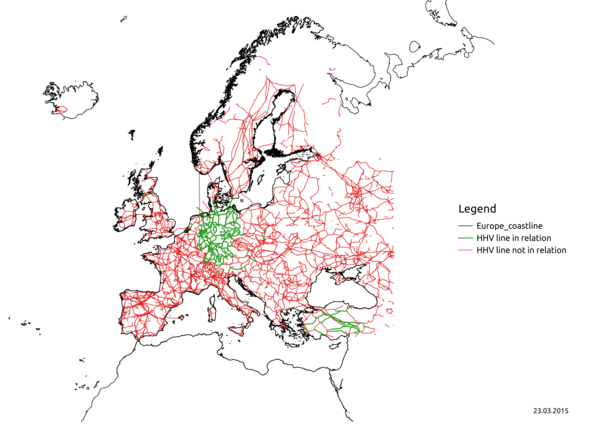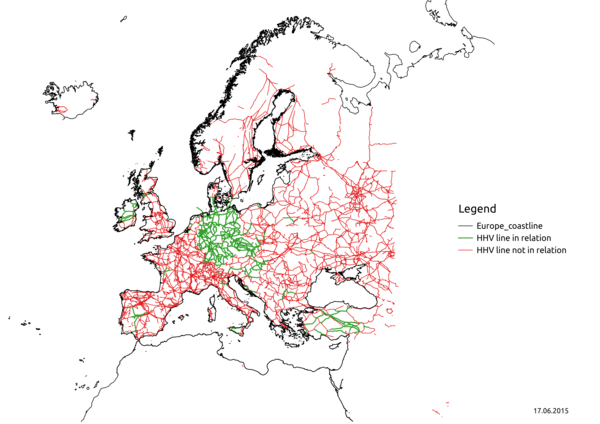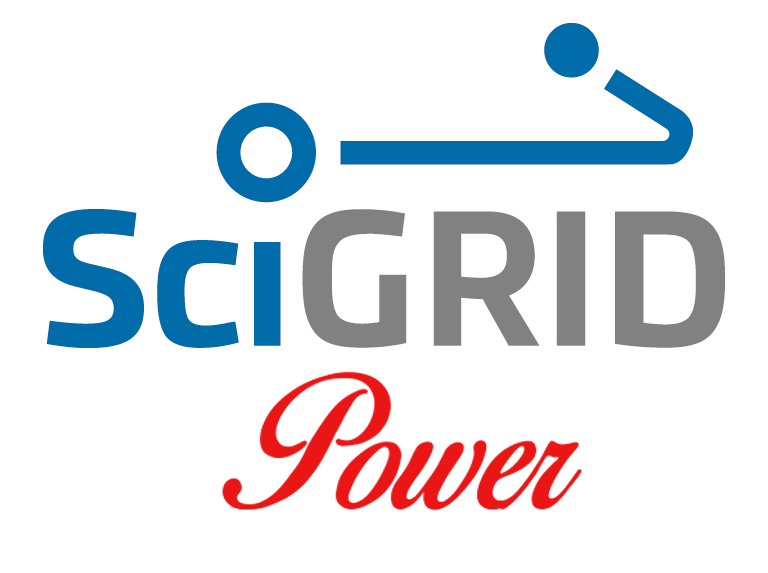Do 02 Juli 2015 | -- (permalink)
The transmission power data used as input in the SciGRID model is based on the data available in OpenStreetMap. The "power" data is represented by three data types, called data primitives, and they are defined in the context of power transmission as follows:
-
nodes: defining points in space, representing transmission towers
-
ways: defining linear features and area boundaries, representing transmission lines, substations, generators, transformers, power-plants, etc.
-
relations: defining logical or geographical relationships between other elements, representing electrical circuits.
For the case of a 3 phase electrical transmission system, 3 cables define a circuit. The relations representing the transmission circuits have the key "route" and value "power" and they are composed of substation(s) and transmission line(s). An example of a "power" relation is shown in the following (© OpenStreetMap Contributors):
<relation id="1637161">
<member type="way" ref="245128569" role="line"/>
<member type="way" ref="118942023" role="line"/>
<member type="way" ref="30181272" role="line"/>
<member type="way" ref="177829920" role="substation"/>
<member type="way" ref="106684941" role="line"/>
<member type="way" ref="23837631" role="substation"/>
<tag k="cables" v="3"/>
<tag k="color" v="white"/>
<tag k="colour" v="white"/>
<tag k="frequency" v="50"/>
<tag k="from" v="Conneforde"/>
<tag k="operator" v="TenneT"/>
<tag k="ref" v="304"/>
<tag k="route" v="power"/>
<tag k="to" v="Diele"/>
<tag k="type" v="route"/>
<tag k="voltage" v="380000"/>
<tag k="wires" v="double"/>
</relation>
Above, the relation OSM-ID:1637161 is composed of 4 transmission lines and two substations. In the SciGRID model, the "power" relations are filtered from the planet OSM data using Osmosis. Then the "power" relations data is abstracted to construct the transmission network. The relation substations are abstracted to represent the transmission network vertices and the lines are abstracted to represent the network links. The tags and geo-information belonging to the edges and links are conserved. The tags can for example provide technical information about the transmission network components, eg. the voltage level and the number of wires for power lines. For more information about the abstraction process in SciGRID we refer to the SciGRID v0.1 User Guide.
In the SciGRID project, "power" relations were "exclusively" used to construct the transmission network model. It is very convenient to use the power relations as input as they "encapsulate" the transmission network components, which makes the task of building the network ready for being automized. Power relations offer the following advantages:
- The input data necessary for building the transmission network is condensed in a logical manner, as relations directly represent the transmission circuits.
- The filtering and abstraction steps are simplified and automated.
- Heuristic approaches, which can be time and ressources demanding, such as power lines routing and shortest path search, can be avoided and manuals "adjustments" of the derived data sets is not required.
- The update of the transmission network can be automated.
Power relations are typically constituted of one or more substations and one or more transmission lines. In the first release of SciGRID we used relations with only 2 substations or with 3 substations and a T-junction. This simplification was used as it is straightforward to extract the network model when only considering such relations. Relations which have more than 3 substations were not considered in a first approximation due to the difficulty of calculating length of the individual transmission lines. Relations with zero or one substation were also not considered as they constitute incomplete electrical circuits. It is planned in the next step of the SciGRID project to integrate the discarded "power" relations in the SciGRID model by developing a more elaborated abstraction algorithm.
When mapping power transmission components, there is a priori no requirement to embed the transmission circuits in relations (see for ref1 and ref2). For this reason, the "power" relations coverage of the transmission network in OpenStreetMap is not complete with the exception of Germany. In the following figure, the power transmission components embedded in power relations are plotted for Europe. One can indeed see that the "power" relations coverage in Germany is almost complete, which means that almost all power transmission components are accounted for by the "power" relations. This is not the case for all Europe, where the power relations coverage generally is not yet representative of the transmission network.
 Copyright: © OpenStreetMap contributors
Copyright: © OpenStreetMap contributors
However, we would like to encourage mappers to take the effort to include power relations whenever possible, since these relations make it possible to use the data for routing on power networks. In fact the coverage of the power relations already increased considerably, as can be seen from a comparison of the figure above with the coverage only tree months later:
 Copyright: © OpenStreetMap contributors
Copyright: © OpenStreetMap contributors
We will recommend everyone who wants to improve the coverage or accuracy of the SciGRID model to consider completing or correcting the data at it's source, the OSM database, since this seems to be the most sustainable way towards open power data. And we are of course glad about support from mappers including or completing information on relations in power systems.
Please do not hesitate to contact us via developers(at)scigrid.de in case of any questions.
